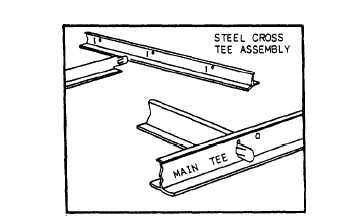Figure 5-25.—Steel cross tee assembly.
Most ceiling panel patterns are random and do not
require orientation. However, some fissured panels are
designed to be installed in a specific direction and are
so marked on the back with directional arrows. When
installing panels on a large project, you should work
from several cartons. The reason for this is that the color,
pattern, or texture might vary slightly; and by working
from several cartons, you avoid a noticeable change in
uniformity.
Since ceiling panels are prefinished, handle them
with care. Keep their surfaces clean by using talcum
powder on your hands or by wearing clean canvas
gloves. If panels do become soiled, use an art gum eraser
to remove spots, smudges, and fingerprints. Some
panels can be lightly washed with a sponge dampened
with a mild detergent solution. However, before washing
or performing other maintenance services, such as
painting, refer to the manufacturer’s instructions.
Ceiling Tile
Ceiling tile can be installed in several ways,
depending on the type of ceiling or roof construction.
When a flat-surfaced backing is present, such as
between beams of a beamed ceiling in a low-slope roof,
tiles are fastened with adhesive as recommended by the
manufacturer. A small spot of a mastic type of con-
struction adhesive at each corner of a 12-by 12-inch tile
is usually sufficient. When tile is edge-matched, stapling
is also satisfactory.
Perhaps the most common method of installing
ceiling tile uses wood strips nailed across the ceiling
joists or roof trusses (fig. 5-26, view A). These are
Figure 5-26.—Ceiling tile assembly.
5-19





